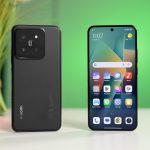
Smartphones are notoriously dirty. You’ve probably heard the toilet seat analogies before: The average phone is anywhere from seven to 10 times dirtier than most porcelain thrones, depending on who you ask, and one in six is supposedly contaminated with fecal matter. If you’re checking your phone as often as most people — that is, about once every 10 minutes — that’s a lot of exposure to a lot of bacteria.
If your phone’s starting to get gross, Apple, Google, and major Android manufacturers like Samsung, LG, Huawei, and Motorola all recommend swabbing it down with a soft, lint-free cloth, a hint of warm, soapy water, and a dab of rubbing alcohol. But as with cleaning any electronic device, this requires an extremely careful hand: Any excess moisture will do some serious damage if it gets into a port or crack. You also risk stripping the screen’s protective coating, which makes it more prone to smudges and fingerprints.
Consider, too, that you really have no way of telling whether you missed a spot when you give your phone a quick wipe-down — those poop germs could still be chilling there while you text, talk, and watch TikTok. There’s got to be a better way, right?
That’s the general idea behind ultraviolet (UV) phone sanitisers, anyway.f
What is a UV phone sanitiser?
Sanitising devices that use UV light to kill pathogens and superbugs have been around in the medical field for decades now, but consumer-friendly adaptations are a more recent development and have gained significant popularity amid the COVID-19 pandemic.
A UV phone sanitiser is essentially just a small plastic or metal box containing a couple of UV bulbs or lamps, which shine onto your device during the disinfection cycle. Aside from avoiding moisture, fumes, and residue, the most obvious draw is the sheer convenience factor: You just pop your phone into the sanitiser’s chamber, close its lid, and let it do its thing for about five to 10 minutes.
For best results, make sure you take your device out of its case before sanitising it — you can run that through separately afterward.
How does UV light kill germs?
UV light is a form of electromagnetic radiation you usually encounter in the form of sunlight, though it can also be recreated using artificial light sources. There are three different types of UV rays:
-
UV-A rays have the longest wavelengths. You’ll find these in tanning beds, bug zappers, and in the blacklights of your local club.
-
UV-B rays have slightly shorter wavelengths. These can help skin produce Vitamin D3 (but may also cause sunburn) and are mostly used in tanning beds alongside UV-A radiation.
-
UV-C rays have the shortest wavelengths. These are typically used for disinfection purposes, as they can damage microbes’ DNA. This either kills them outright or prevents them from functioning and reproducing.
Note: All mentions of UV light hereafter refer to UV-C rays specifically.
Is UV light dangerous?
UV light is far more dangerous to a microbe than a human being, but the U.S. Food and Drug Administration still recommends exercising some caution around it: “Direct exposure of skin and eyes to UV-C radiation from some UVC lamps may cause painful eye injury and burn-like skin reactions. Never look directly at a UVC lamp source, even briefly.”
The FDA further notes that UV light can degrade plastic and polymers, but fret not: You’d need hours of continuous exposure to do any notable damage to your phone.
Do UV phone sanitisers really work?
PCMag’s consumer electronics analyst Steven Winkelman has already tackled this topic in a thorough explainer, which you can read here. (Full disclosure: PCMag is owned by Mashable’s publisher, Ziff Davis.) We won’t rehash the whole thing, but the gist of it is this: Kind of.
While UV light itself is really good at eliminating and stopping the spread of certain bacteria (including E. coli and Salmonella), the kinds of UV sanitisers being sold to the public are pretty dinky compared to the ones used in hospitals.
“Many of the UVC lamps sold for home use are of low dose,” the FDA says, “so it may take longer exposure to a given surface area to potentially provide effective inactivation of a bacteria or virus.”
To that end, it’s also important to note that while most manufacturers say their phone sanitisers are 99.99% effective against common germs, very few can back up their claims with third-party lab testing.
We already know that hand-washing, wearing masks, social distancing, and getting vaccinated are quite good at keeping us germ-free — and those methods are all free or extremely cheap. All things considered, UV sanitation should be your “second line of defense” against viruses and bacteria, Winkelman says.
Are UV sanitisers effective against COVID-19?
The National Academies of Sciences, Engineering, and Medicine have confirmed that UV light is capable of destroying SARS-CoV-2, the virus that causes COVID-19, but that also comes with a pretty big caveat: No consumer-grade phone sanitisers have been lab-tested against COVID, even the rare few that have undergone testing against other germs.
Keep in mind, too, that COVID is primarily an airborne virus. “[Studies] show the virus is rarely viable on surfaces,” Winkelman writes, “and the CDC states that transmission from contaminated surfaces ‘is not thought to be a common way that COVID-19 spreads.'”
If you’re thinking about getting a UV sanitiser for the sole purpose of protecting yourself from COVID, you’re probably better off with a face mask and a jab.
What is the best UV phone sanitiser?
We have searched high and low for the best UV sanitisers for your phone. We’ve tried to find something for every budget, and it’s worth checking out everything in this list before making any sort of decision.
These are the best UV phone sanitisers in 2022.
Powered by WPeMatico






